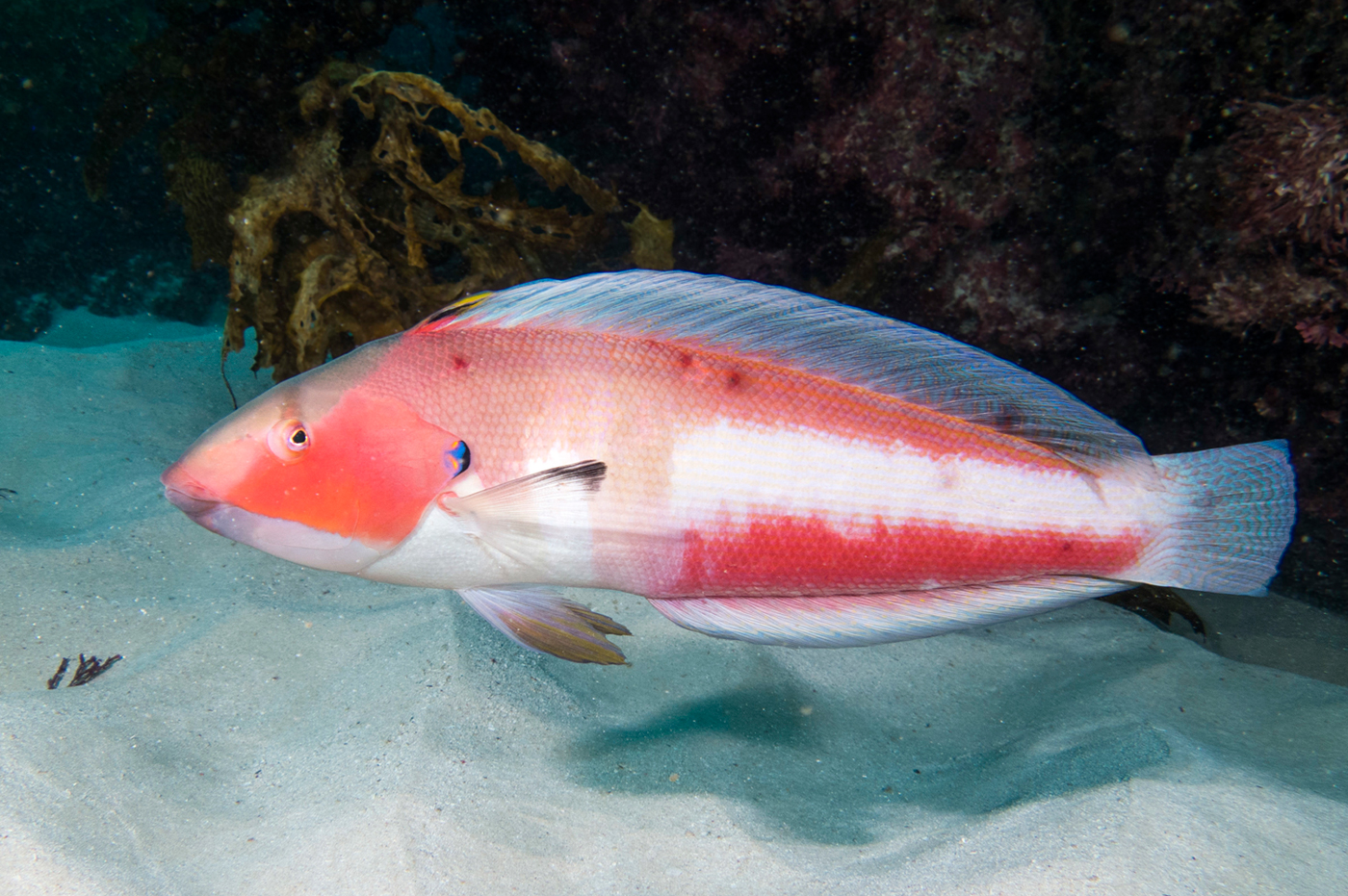- Classification
- ACTINOPTERYGII
- PERCIFORMES
- LABRIDAE
- Coris
- auricularis
Western King Wrasse, Coris auricularis (Valenciennes 1839)

A male Western King Wrasse, Coris auricularis, at Rottnest Island, Western Australia, June 2019. Source: John Turnbull / Flickr. License: CC by Attribution-NonCommercial-ShareAlike
Lives in small haremic groups with a dominant male controlling several juveniles and females.
Western King Wrasse, Coris auricularis (Valenciennes 1839)
More Info
|
Distribution |
Investigator Group, South Australia, to Exmouth, Western Australia. The species is most abundant between Perth and Geraldton. The most abundant wrasse over reefs in many parts of its range. Commonly inhabits sandy areas and seagrass beds on offshore reefs. |
|
Features |
Dorsal fin IX, 12; Anal fin III, 12; Caudal fin 14; Pectoral fin 14; Pelvic fin I, 5; lateral line scales 83-84. Body shallow (approx. 26% SL), moderately elongate, compressed; head small (approx. 26% SL), dorsal profile convex; eyes small (approx. 17% HL); mouth small, upper jaw not reaching as far as eye; mouth relatively small, with small conical pointed teeth in a single row in jaws, anterior pair in each jaw enlarged and outwardly curved; prominent canines absent from rear of jaw. Scales very small, cycloid, firmly attached, covering body but not head, body scales not extending onto base of dorsal and anal fin; lateral line bent abruptly downwards beneath soft dorsal fin. Dorsal fin continuous, with elongate base and uniform height; anal fin similar to and opposite rear half of dorsal fin; caudal fin truncate. Pectoral fins moderately long, upper rays longest. Pelvic fins moderately long, arising beneath pectoral fin bases, reaching to or near anus. |
|
Colour |
The Western King Wrasse changes sex from female to male during its lifecycle and undergoes corresponding marked colour changes. Juveniles are dark reddish to black with a narrow white mid-dorsal stripe from the snout to the tail, and a broader white mid-lateral stripe; ventral surface whitish. Adult females are pale greenish-white with a reddish-brown band tapering from the snout through the eye along the body just above lateral line. Adult males are salmon pink, top of head pale bluish, chin and throat whitish, and a bluish-black mark on the rear edge of the operculum; thoracic area yellowish followed by a broad white vertical band; a diffuse dusky or pale stripe from mid-body to the caudal-fin base. |
|
Feeding |
Forages in groups over sandy areas very close to reefs. Feeds mostly on small crustaceans such as amphipods and isopods, gastropod molluscs and to a lesser extent on larger crustaceans such as brachyuran crabs. Also consumes a range of other benthic invertebrates including marine worms and bivalve molluscs. Juveniles and small adult females may act as 'cleaner fishes' and congregate at 'cleaner stations', removing skin parasites from other fish species. |
|
Biology |
This species is a protogynous hermaphrodite and changes sex from female to male during its life cycle, accompanied by dramatic colour changes. Adult males are territorial and control harems comprised of many juveniles and adult females. Spawning occurs during late summer and autumn. |
|
Etymology |
The specific name auricularis is from the Latin auricula (= ear) in reference to the blue mark on the rear of the gill cover of large males. |
|
Species Citation |
Julis auricularis Valenciennes, 1839, Histoire Naturelle des Poissons 13: 489. Type locality: King George Sound, Western Australia. |
|
Author |
Bray, D.J. 2020 |
|
Resources |
Western King Wrasse, Coris auricularis (Valenciennes 1839)
References
Lek, E. 2011. Comparisons between the biological characteristics of three co-occurring and reef-dwelling labrid species at two different latitudes. PhD thesis, Murdoch University.
Lek, E., Fairclough, D.V., Hall, N.G., Hesp, S.A. & Potter, I.C. 2012. Do the maximum sizes, ages and patterns of growth of three reef-dwelling labrid species at two latitudes differ in a manner conforming to the metabolic theory of ecology? Journal of Fish Biology 81: 1936–1962. https://doi.org/10.1111/j.1095-8649.2012.03446.x











